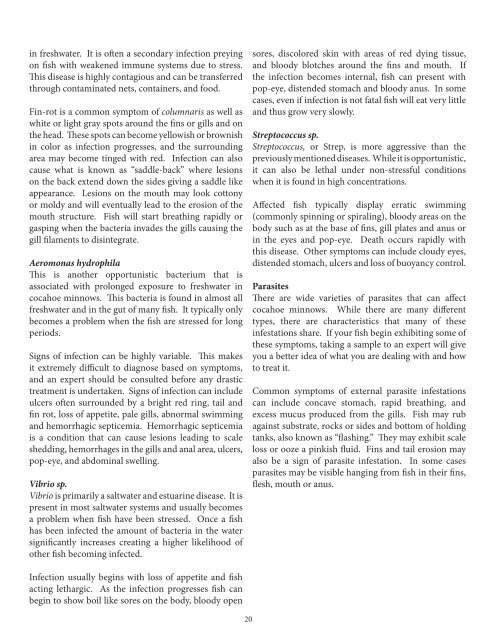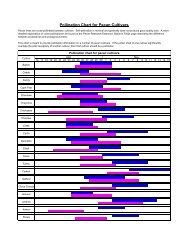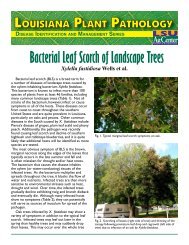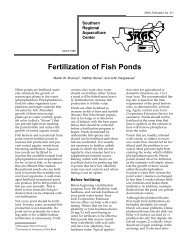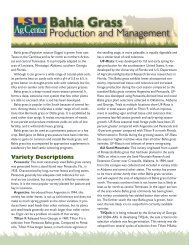Cocahoe Minnow - The LSU AgCenter
Cocahoe Minnow - The LSU AgCenter
Cocahoe Minnow - The LSU AgCenter
You also want an ePaper? Increase the reach of your titles
YUMPU automatically turns print PDFs into web optimized ePapers that Google loves.
in freshwater. It is often a secondary infection preying<br />
on fish with weakened immune systems due to stress.<br />
This disease is highly contagious and can be transferred<br />
through contaminated nets, containers, and food.<br />
Fin-rot is a common symptom of columnaris as well as<br />
white or light gray spots around the fins or gills and on<br />
the head. <strong>The</strong>se spots can become yellowish or brownish<br />
in color as infection progresses, and the surrounding<br />
area may become tinged with red. Infection can also<br />
cause what is known as “saddle-back” where lesions<br />
on the back extend down the sides giving a saddle like<br />
appearance. Lesions on the mouth may look cottony<br />
or moldy and will eventually lead to the erosion of the<br />
mouth structure. Fish will start breathing rapidly or<br />
gasping when the bacteria invades the gills causing the<br />
gill filaments to disintegrate.<br />
Aeromonas hydrophila<br />
This is another opportunistic bacterium that is<br />
associated with prolonged exposure to freshwater in<br />
cocahoe minnows. This bacteria is found in almost all<br />
freshwater and in the gut of many fish. It typically only<br />
becomes a problem when the fish are stressed for long<br />
periods.<br />
Signs of infection can be highly variable. This makes<br />
it extremely difficult to diagnose based on symptoms,<br />
and an expert should be consulted before any drastic<br />
treatment is undertaken. Signs of infection can include<br />
ulcers often surrounded by a bright red ring, tail and<br />
fin rot, loss of appetite, pale gills, abnormal swimming<br />
and hemorrhagic septicemia. Hemorrhagic septicemia<br />
is a condition that can cause lesions leading to scale<br />
shedding, hemorrhages in the gills and anal area, ulcers,<br />
pop-eye, and abdominal swelling.<br />
Vibrio sp.<br />
Vibrio is primarily a saltwater and estuarine disease. It is<br />
present in most saltwater systems and usually becomes<br />
a problem when fish have been stressed. Once a fish<br />
has been infected the amount of bacteria in the water<br />
significantly increases creating a higher likelihood of<br />
other fish becoming infected.<br />
Infection usually begins with loss of appetite and fish<br />
acting lethargic. As the infection progresses fish can<br />
begin to show boil like sores on the body, bloody open<br />
20<br />
sores, discolored skin with areas of red dying tissue,<br />
and bloody blotches around the fins and mouth. If<br />
the infection becomes internal, fish can present with<br />
pop-eye, distended stomach and bloody anus. In some<br />
cases, even if infection is not fatal fish will eat very little<br />
and thus grow very slowly.<br />
Streptococcus sp.<br />
Streptococcus, or Strep, is more aggressive than the<br />
previously mentioned diseases. While it is opportunistic,<br />
it can also be lethal under non-stressful conditions<br />
when it is found in high concentrations.<br />
Affected fish typically display erratic swimming<br />
(commonly spinning or spiraling), bloody areas on the<br />
body such as at the base of fins, gill plates and anus or<br />
in the eyes and pop-eye. Death occurs rapidly with<br />
this disease. Other symptoms can include cloudy eyes,<br />
distended stomach, ulcers and loss of buoyancy control.<br />
Parasites<br />
<strong>The</strong>re are wide varieties of parasites that can affect<br />
cocahoe minnows. While there are many different<br />
types, there are characteristics that many of these<br />
infestations share. If your fish begin exhibiting some of<br />
these symptoms, taking a sample to an expert will give<br />
you a better idea of what you are dealing with and how<br />
to treat it.<br />
Common symptoms of external parasite infestations<br />
can include concave stomach, rapid breathing, and<br />
excess mucus produced from the gills. Fish may rub<br />
against substrate, rocks or sides and bottom of holding<br />
tanks, also known as “flashing.” <strong>The</strong>y may exhibit scale<br />
loss or ooze a pinkish fluid. Fins and tail erosion may<br />
also be a sign of parasite infestation. In some cases<br />
parasites may be visible hanging from fish in their fins,<br />
flesh, mouth or anus.


